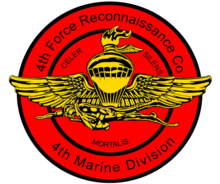
Force Reconnaissance (FORECON) are United States Marine Corps reconnaissance units that provide amphibious reconnaissance, deep ground reconnaissance, surveillance, battle-space shaping and limited scale raids in support of a Marine Expeditionary Force (MEF), other Marine air-ground task forces or a joint force. As conventional forces, during large-scale operations, Force Reconnaissance companies report to the Marine Expeditionary Force (MEF) and provide direct action and deep reconnaissance. Though commonly misunderstood to refer to reconnaissance-in-force, the name "Force" Recon refers to the unit's relationship with the Marine Expeditionary Force or Marine Air-Ground Task Force. Force reconnaissance platoons formed the core composition of the initial creation of the Marine Special Operations Teams (MSOTs) found in Marine Forces Special Operations Command (MARSOC) Raider battalions, though Marine Raiders now have their own separate and direct training pipeline.

A long-range reconnaissance patrol, or LRRP, is a small, well-armed reconnaissance team that patrols deep into enemy-held territory.

The 4th Marine Division is a reserve division in the United States Marine Corps. It was raised in 1943 for service during World War II, and subsequently fought in the Pacific against the Japanese. Deactivated after the war, the division was re-formed in 1966 and elements of the division deployed during the Gulf War in 1990–1991, as well as during the Iraq War. It is currently the ground combat element of the Marine Forces Reserve and is headquartered in New Orleans, Louisiana, and has units throughout the United States.
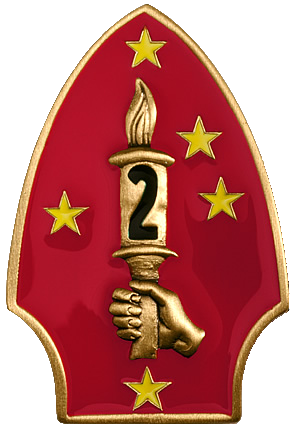
The 2nd Marine Division is a division of the United States Marine Corps, which forms the ground combat element of the II Marine Expeditionary Force. The division is based at Marine Corps Base Camp Lejeune, North Carolina and headquartered at Julian C. Smith Hall.
In the United States Marine Corps, a Marine air–ground task force is the principal organization for all missions across the range of military operations. MAGTFs are a balanced air–ground, combined arms task organization of Marine Corps forces under a single commander that is structured to accomplish a specific mission. The MAGTF was formalized by the publishing of Marine Corps Order 3120.3 in December 1963, "The Marine Corps in the National Defense, MCDP 1-0". It stated:
A Marine air–ground task force with separate air ground headquarters is normally formed for combat operations and training exercises in which substantial combat forces of both Marine aviation and Marine ground units are included in the task organization of participating Marine forces.

The 3rd Reconnaissance Battalion conducts amphibious and ground reconnaissance in support of the 3rd Marine Division and Marine Forces Pacific (MarForPac), operating in the commander's areas of influence. The battalion is based out of Camp Schwab, a satellite base of Marine Corps Base Camp Smedley D. Butler. It is geographically located on the Okinawa Prefecture in Japan.
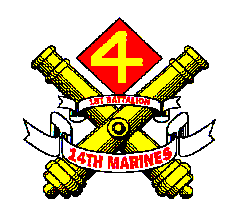
1st Battalion 14th Marines (1/14) was a reserve artillery battalion comprising three firing batteries and a headquarters battery. The battalion was based in Alameda, California. Its primary weapon system was the M198 Howitzer. It was part of the 14th Marine Regiment of the 4th Marine Division.

5th Battalion, 14th Marines (5/14) is a reserve artillery battalion of the United States Marine Corps comprising four firing batteries and a headquarters battery. The battalion is based in Seal Beach, California and its primary weapon system is the M777A2 howitzer with a maximum effective range of 40 km. They fall under the command of the 14th Marine Regiment and the 4th Marine Division.
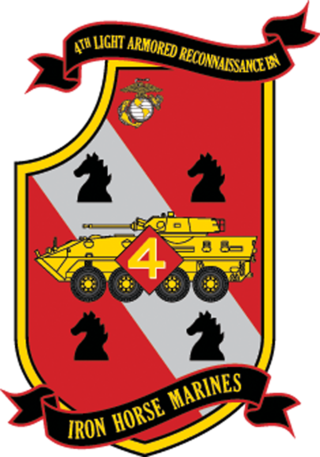
4th Light Armored Reconnaissance Battalion is a United States Marine Corps Light Armored Reconnaissance battalion of the Marine Corps Reserve. Their primary weapon system is the LAV-25 and they are part of the 4th Marine Division and Marine Forces Reserve. The unit headquarters is at Camp Pendleton, California, but other units in the battalion are located throughout the United States. 4th LAR Bn is the largest combat battalion in the Marine Corps, with 7 companies.

The 2nd Reconnaissance Battalion is a reconnaissance battalion in the United States Marine Corps. Located at Marine Corps Base Camp Lejeune, North Carolina, the battalion falls under the command of the 2nd Marine Division and the II Marine Expeditionary Force.

The 4th Reconnaissance Battalion is a reserve reconnaissance battalion in the United States Marine Corps. It falls under the 4th Marine Division and Marine Forces Reserve.

The United States Marine Corps is organized within the Department of the Navy, which is led by the Secretary of the Navy (SECNAV). The most senior Marine commissioned officer is the Commandant of the Marine Corps, responsible for organizing, recruiting, training, and equipping the Marine Corps so that it is ready for operation under the command of the unified combatant commanders. The Marine Corps is organized into four principal subdivisions: Headquarters Marine Corps, the Operating Forces, the Supporting Establishment, and the Marine Forces Reserve.
The United States Marine Corps' Anti-Terrorism Battalion was a specialized infantry battalion. The battalion was disbanded in 2013.

The 196th Infantry Brigade ("Chargers"), also known as the Charger Brigade was first formed on 24 June 1921 as part of the United States Army Reserve's 98th Division with the responsibility of training soldiers.

1st Marine Expeditionary Brigade is a unit in the I Marine Expeditionary Force and is the "middleweight" global crisis response force.
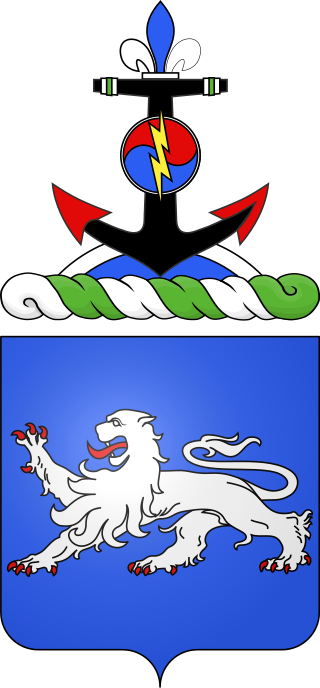
The 68th Armor Regiment is an armored regiment of the United States Army. It was first activated in 1933 in the Regular Army as the 68th Infantry Regiment.
The 32nd Infantry Regiment is a battalion within the United States Army. Of the original regiment, only the 1st Battalion remains as an active duty unit. The 1st Battalion, 32nd Infantry Regiment is a light infantry battalion assigned to the 1st Brigade Combat Team, 10th Mountain Division, garrisoned at Fort Drum, New York. The battalion was previously assigned to the 3rd Brigade Combat Team at Fort Drum, before this unit was reflagged to Fort Johnson, formerly Fort Polk, Louisiana.

1st Force Reconnaissance Company conducted deep reconnaissance and direct action raids in support of I Marine Expeditionary Force requirements across the range of military operations to include crisis response, expeditionary operations and major combat operations. 1st Force Recon Company was deactivated on 26 October 2006 and the majority of the personnel were used to establish the 1st Marine Special Operations Battalion.

3d Force Reconnaissance Company is a force reconnaissance unit of the United States Marine Corps Reserve. The company is located in Mobile, Alabama.

The 525th Expeditionary Military Intelligence Brigade (Expeditionary) is a unit of the United States Army specializing in the acquisition and analysis of information with potential military value. On 28 October 2014, the unit was reflagged from the "525th Battlefield Surveillance Brigade" to an expeditionary military intelligence brigade, the first of its kind.
